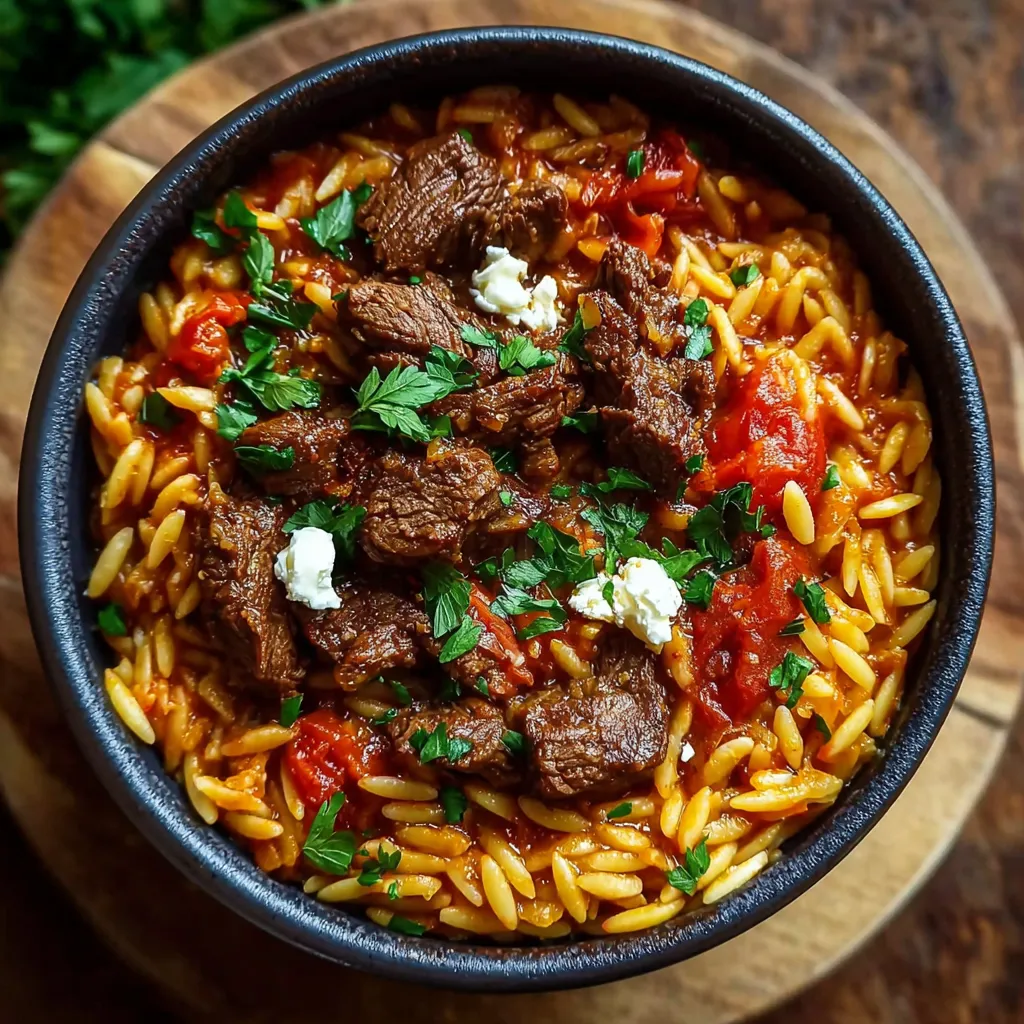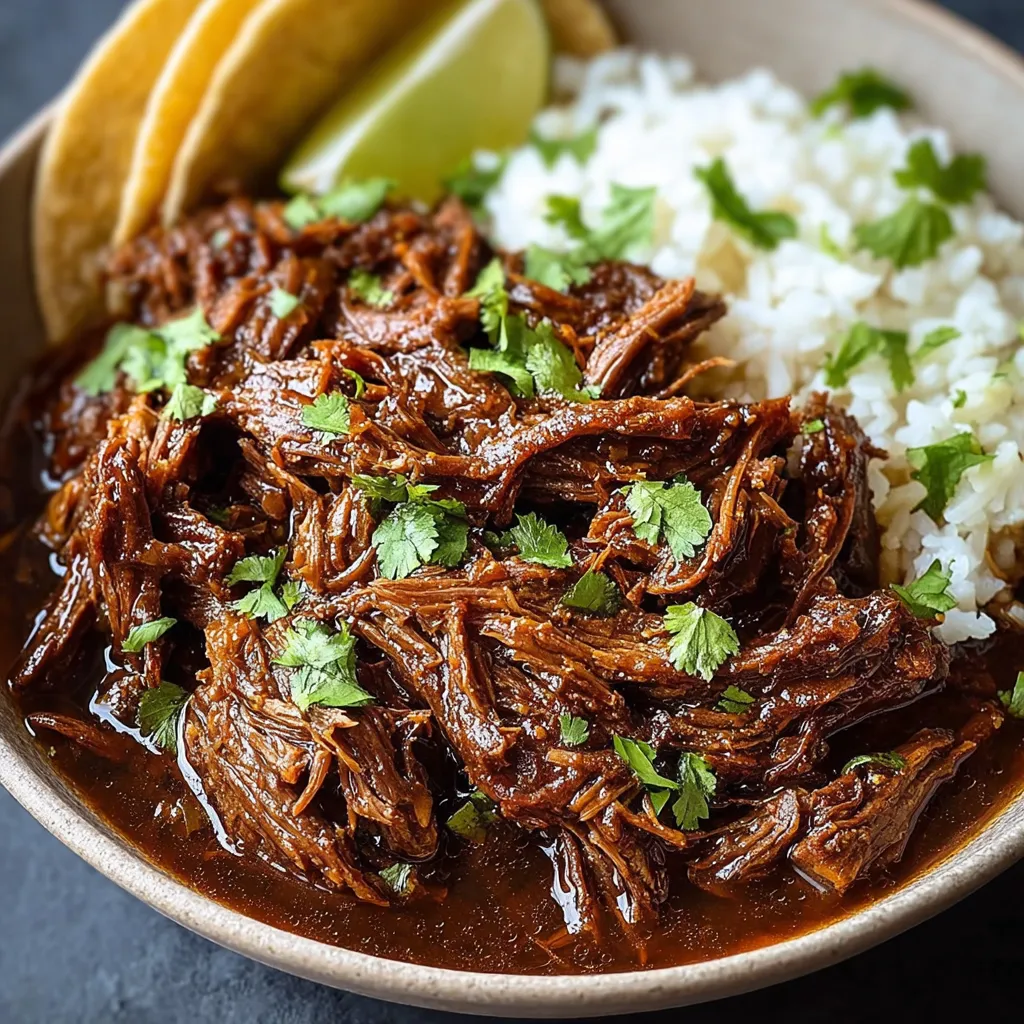Decoding the Deliciousness: The Science Behind Giouvetsi
At its heart, Beef Giouvetsi is a study in controlled braising and starch gelatinization. The key to tender beef is low and slow cooking, allowing collagen, a tough protein found in connective tissues, to break down into gelatin, which provides a rich, melt-in-your-mouth texture. Simultaneously, the acid in the tomatoes helps to further tenderize the meat. The orzo, a small pasta resembling rice, requires careful attention. Overcooking results in a mushy, gluey mess, while undercooking leaves it hard and unpleasant. The goal is to achieve a perfectly “al dente” texture, where the orzo is cooked through but still retains a slight bite. The starch in the orzo also contributes to the sauce’s thickness, creating a luscious coating for the beef and pasta. Understanding Maillard reaction is also crucial. Searing the beef before braising creates deep, complex flavors that enhance the overall profile of the dish. Lastly, the feta cheese, often added at the end, provides a salty, tangy counterpoint to the richness of the sauce and beef.The Ultimate Beef Giouvetsi Recipe
 This recipe reflects my extensive research and experimentation, incorporating techniques that consistently produce exceptional results.
This recipe reflects my extensive research and experimentation, incorporating techniques that consistently produce exceptional results.
Ingredients:
- 3 lbs Beef chuck roast, cut into 1.5-inch cubes
- 2 tbsp Olive oil
- 1 large Onion, chopped
- 2 cloves Garlic, minced
- 1 tbsp Tomato paste
- 1 (28 oz) can Crushed tomatoes
- 1 (14.5 oz) can Diced tomatoes, undrained
- 1 cup Dry red wine (optional, but highly recommended)
- 4 cups Beef broth
- 1 tsp Dried oregano
- 1/2 tsp Dried thyme
- 1 Bay leaf
- Salt and pepper to taste
- 1 lb Orzo pasta
- 1/2 cup Grated Kefalotyri cheese or Parmesan cheese (optional)
- 4 oz Feta cheese, crumbled, for serving
- Fresh parsley, chopped, for garnish
Instructions:
- Sear the Beef: Preheat oven to 325°F (160°C). Pat the beef cubes dry with paper towels. Season generously with salt and pepper. Heat olive oil in a large Dutch oven or oven-safe pot over medium-high heat. Sear the beef in batches until browned on all sides. Remove the beef from the pot and set aside.
- Sauté Aromatics: Add the chopped onion to the pot and cook until softened, about 5-7 minutes. Add the minced garlic and tomato paste, and cook for another minute until fragrant.
- Deglaze and Combine: If using, pour in the red wine and scrape the bottom of the pot to loosen any browned bits. Cook for 2-3 minutes until the wine has reduced slightly. Add the crushed tomatoes, diced tomatoes (undrained), beef broth, oregano, thyme, and bay leaf. Bring to a simmer.
- Braise the Beef: Return the seared beef to the pot. Cover the pot and transfer it to the preheated oven. Braise for 2.5-3 hours, or until the beef is very tender and easily pierced with a fork.
- Cook the Orzo: Remove the pot from the oven. Discard the bay leaf. Bring the sauce to a simmer over medium heat on the stovetop. Stir in the orzo pasta.
- Finish in the Oven (Optional): Cover the pot and return it to the oven for another 15-20 minutes, or until the orzo is cooked through and has absorbed most of the liquid. Alternatively, continue cooking on the stovetop, stirring frequently, until the orzo is cooked and the sauce has thickened.
- Rest and Serve: Remove the pot from the oven or stovetop. Let it rest for 10 minutes before serving. This allows the orzo to fully absorb the sauce and the flavors to meld.
- Garnish and Serve: Stir in the grated Kefalotyri cheese or Parmesan cheese (if using). Serve hot, garnished with crumbled feta cheese and chopped fresh parsley.
My Giouvetsi Journey: The Investigation
My first few attempts were a disaster. The beef was tough, the orzo was either mushy or crunchy, and the sauce tasted flat. Like many of you, I initially thought it was just a matter of following a recipe. But I soon realized that understanding the “why” behind each step was crucial.The Beef Battle: Taming Toughness
Initially, I used a leaner cut of beef, thinking it would be healthier. Big mistake! The lack of fat resulted in dry, stringy meat. Then, I had an “Aha!” moment: chuck roast, with its generous marbling and ample connective tissue, was the key. The low and slow braising transformed the tough collagen into luscious gelatin, yielding incredibly tender beef. I also played around with searing times. I found that a deep, rich sear on all sides dramatically improved the overall flavor, developing those crucial Maillard reaction compounds. I even considered using my Instant Pot Chuck Roast recipe as a starting point, but ultimately decided the oven’s gentle heat was superior for Giouvetsi.Orzo Ordeal: Avoiding the Mush
The orzo presented another challenge. My early attempts resulted in a gluey, overcooked mess. I tried rinsing the orzo before adding it to the sauce, thinking it would remove excess starch. It helped a little, but the real breakthrough came when I reduced the amount of liquid and monitored the cooking time *very* closely. Cooking the orzo directly in the sauce is what gives the dish its unique character, but it’s a delicate balancing act. Adding the pasta at the end, instead of braising it with the beef, also helped me control the texture. I even tried using different types of orzo. The larger variety holds its shape better and is less prone to mushiness. It reminds me of the way that Cabbage Beef Bake needs the right type of rice to hold its form.Sauce Secrets: Flavor Amplification
The sauce was the final piece of the puzzle. My initial sauces lacked depth and complexity. I experimented with different types of tomatoes, adding a touch of tomato paste for concentrated flavor, and deglazing the pot with red wine. The red wine added a subtle fruity note that complemented the richness of the beef. Fresh herbs also made a significant difference. While dried oregano and thyme are essential, a sprinkle of fresh parsley at the end brightened the dish and added a pop of color. I also found that letting the Giouvetsi rest for 10 minutes after cooking allowed the orzo to fully absorb the sauce and the flavors to meld together. I even considered adding some of the vegetables from Vegetable Beef Soup into the mix to add some extra nuance.The Giouvetsi Guarantee: Foolproof Technique
After countless iterations, I’ve developed a foolproof technique for achieving perfect Beef Giouvetsi every time:- Choose the Right Beef: Opt for chuck roast, cut into 1.5-inch cubes. The marbling and connective tissue are essential for tender, flavorful beef.
- Sear for Success: Pat the beef dry and sear it in batches until deeply browned on all sides. This develops rich, complex flavors.
- Build the Flavor Base: Sauté onions and garlic, then add tomato paste and cook until fragrant. Deglaze with red wine (optional) for added depth.
- Braise Low and Slow: Combine all ingredients in a Dutch oven and braise in a preheated oven at 325°F (160°C) for 2.5-3 hours, or until the beef is very tender.
- Orzo Precision: Add the orzo pasta to the sauce and cook until al dente, monitoring the cooking time closely to avoid overcooking. I find it works best to cover and put back in the oven for 15-20 minutes.
- Rest and Re-absorb: Let the Giouvetsi rest for 10 minutes before serving to allow the orzo to fully absorb the sauce and the flavors to meld.
- Feta Finish: Garnish with crumbled feta cheese and fresh parsley for a salty, tangy, and refreshing touch.
Why is chuck roast the recommended cut of beef for Giouvetsi?
Chuck roast is recommended because its generous marbling and ample connective tissue transform during low and slow braising. The collagen breaks down into gelatin, resulting in incredibly tender and flavorful beef.
What’s the best way to avoid mushy orzo in Beef Giouvetsi?
To avoid mushy orzo, reduce the amount of liquid, monitor the cooking time very closely, add the orzo towards the end of the cooking process, and consider using a larger variety of orzo that holds its shape better. Letting it rest allows the orzo to absorb the sauce.
Why is searing the beef so important in this recipe?
Searing the beef before braising is crucial for developing rich, complex flavors through the Maillard reaction. This deep sear on all sides significantly enhances the overall flavor profile of the dish.
Can I use a different cheese if I don’t have Kefalotyri?
Yes, the recipe suggests that you can use grated Parmesan cheese as an alternative to Kefalotyri cheese. Feta cheese is still recommended for serving.

Best Beef Giouvetsi Ever
Ingredients
Equipment
Method
- Preheat oven to 325°F (160°C). Pat the beef cubes dry with paper towels. Season generously with salt and pepper.
- Heat olive oil in a large Dutch oven or oven-safe pot over medium-high heat. Sear the beef in batches until browned on all sides. Remove the beef from the pot and set aside.
- Add the chopped onion to the pot and cook until softened, about 5-7 minutes. Add the minced garlic and tomato paste, and cook for another minute until fragrant.
- If using, pour in the red wine and scrape the bottom of the pot to loosen any browned bits. Cook for 2-3 minutes until the wine has reduced slightly. Add the crushed tomatoes, diced tomatoes (undrained), beef broth, oregano, thyme, and bay leaf. Bring to a simmer.
- Return the seared beef to the pot. Cover the pot and transfer it to the preheated oven. Braise for 2.5-3 hours, or until the beef is very tender and easily pierced with a fork.
- Remove the pot from the oven. Discard the bay leaf. Bring the sauce to a simmer over medium heat on the stovetop.
- Stir in the orzo pasta.
- Cover the pot and return it to the oven for another 15-20 minutes, or until the orzo is cooked through and has absorbed most of the liquid. Alternatively, continue cooking on the stovetop, stirring frequently, until the orzo is cooked and the sauce has thickened.
- Remove the pot from the oven or stovetop. Let it rest for 10 minutes before serving. This allows the orzo to fully absorb the sauce and the flavors to meld.
- Stir in the grated Kefalotyri cheese or Parmesan cheese (if using). Serve hot, garnished with crumbled feta cheese and chopped fresh parsley.




